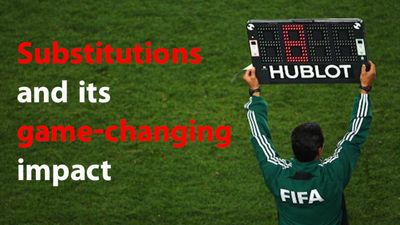In sports like cricket, football, hockey and basketball, not one or two players but the team competes as a unit to clinch victory. While the aforementioned statement is a known fact, what is lesser known among fans is exactly how many substitute players can be used in cricket, football and hockey, three sports played with 11-payers-a-side. In cricket and football, all kinds of substitution rules have been made over the years. At the same time, in sports like field hockey and basketball, the rules for substitute players are different. Let's have a closer look:
Cricket
For the last two centuries, the rules of cricket, have undergone all kinds of changes with changing times in order to make the sport more appealing to the fans. In a sport that is played with two teams comprising 11 players each, the substitution of players has played an important role. In cricket, a maximum of four players can be used as substitutes. Let's take a closer look at when and how are substitute players used during a cricket match:
What is a substitute?
Whenever a player falls ill or gets injured during a cricket match, another player is sent to the field in his place. The substitute cannot bat or bowl without the consent of all parties involved. During New Zealand's tour of India in 1988, a sports journalist from New Zealand played the role of a substitute in a match after the consent of all parties involved, including the umpires. The Substitute's rule has been placed at number 24 in the book of Laws of Cricket.
Fielding substitute
During a cricket match, if a player gets injured while batting in the first innings or if he gets exhausted, then the team puts a player (not part of the playing XI) as a fielding substitute, replacing the batter. However, this substitute cannot bowl and bat on the field. While the batsman will be considered out from the catch taken by him but this catch will not be added to the record of that player's name.
Whenever a player goes out during a match such as a fast bowler with an injury, he cannot come back on the field and start bowling immediately. According to the rules, that player needs to spend the same amount of time on the field after his return for the duration he was off the field. The same goes for a batsman also.
During a cricket match, if a bowler gets injured in the middle of his over, then another player has to complete the over by bowling the remaining deliveries. Only that player is eligible to complete the over who hasn't the bowl previous over and won't be bowling the following one either. At the same time, the fielding substitute who will come to the field to replace the injured bowler, cannot bowl.
Tactical Substitute creates a ruckus
In 2005, the International Cricket Council (ICC) implemented the option of 'Tactical Substitute' to be used only in ODI cricket. In this, the captain, at the time of the toss, named a player who could be used at any time during the match. However, the team that won the toss started getting more advantages and cricket legends and commentators all called this rule useless. After the uproar, the ICC abolished this rule in 2006 and in 2008 said that a substitute player will be used in cricket only when a player playing a match is injured, ill or due to other valid reasons.
Concussion substitute
In 2010, the concussion rule was first used in domestic cricket in New Zealand, followed by its usage in county cricket in England (2018) and now it has also been implemented by the ICC. Under the concussion rule, if a player gets a head injury during the match, then a like-to-like substitute comes in his place. In simpler terms, a bowler is replaced by a bowler and likewise. The substituted player can bowl or bat also.
Football
In cricket where the substitute player is used only when a player is injured or ill, there is no such rule in football. In 90 minutes and the added time, a team can use a maximum of five substitute players. A team can only has three chances to bring on substitutes. Once a player comes out of the field, he cannot go back to play in the match again.
Extra time
In a football match, if a team does not use its maximum of five substitute players in 90 minutes, then it can take only one of its players as a substitute in extra time. At the same time, a team can give a substitute list of names of at least three players to a maximum of 15 players. Out of which only five players can be used during a match.
Concussion substitute
Like cricket, concussion substitutes are also used in football. Under this, if a footballer gets a head injury during a match, then the match referee goes to check on the player. The player is then examined by a medical team and the game is stopped. If a player suffers from a concussion, then another player gets a chance to play in his place. However, the concussion substitute differs from the rule of a maximum of five substitutes during a match.
Hockey
In cricket and football, where all kinds of rules and regulations have been made when it comes to the substitution of players, hockey hasn't seen many changes in this regard. The concept of rolling substitute is used in hockey. There are also five substitute players in a hockey match played with 11 players and any number of times any player can be used as a substitute. The unique part of hockey is that the match does not stop because of the substitution, while the players keep changing from the halfway line. Not only this, if a player has scored a goal, then he or she has to go out of the field for two minutes.
Basketball
In basketball also, substitution rules are similar to that of field hockey. In the game of basketball, two teams of five players each compete against each other. Apart from that, there are five substitute players that can be used any number of times during a 48-minute match.
ADVERTISEMENT










